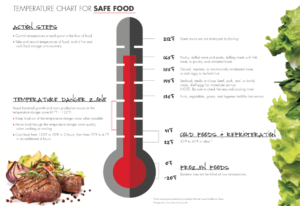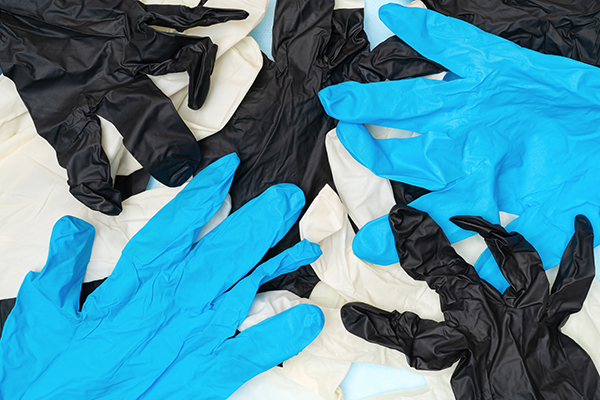SafeBites Time and Temperature Control: Why & When
Hi Everyone – Cathy here. Having written the SafeFood Blog for Iowa State University for over ten years, I am happy to have the opportunity to work with FoodHandler in my retirement. Jeannie and I share with FoodHandler a passion for making sure food served is safe.
You might recall in the June blogs, Jeannie presented the Top 5 reasons why food becomes unsafe, and she discussed controls for two of those in efforts to reduce risk of cross contamination leading to a foodborne illness.
In this month’s blog, the topic of preventing temperature abuse of foods will be covered. This week, the focus is on the “why” and “when” of time and temperature controls. The second blog in July will identify some action steps that can be taken by foodservice employees to control for time and temperature abuse of foods.
Why is time and temperature control for foods so important? For one thing, it contributes to quality of food. Keeping hot foods hot and cold foods cold, and serving food as close as possible to when it was prepared enhances quality. Who wants to eat a dry hamburger, a cool bowl of soup, or wilted lettuce?
In addition to quality, temperature controls that minimize time certain foods are in the temperature danger zone (TDZ) mitigate the risk of bacteria growing to harmful levels. Temperature Controlled for Safety foods, or TCS foods (which were previously known as potentially hazardous foods) have characteristics that are especially conducive to rapid growth of harmful microorganisms. Rapid growth occurs when the food is in the TDZ. The TDZ is that temperature range between refrigeration (below 41° F) and hot holding (135° F or higher). The “super” TDZ is between 70° F and 135° F. It is in this temperature range where reproduction of bacteria takes place at accelerated rates. That is why proper cooling of hot foods is so important. Because of that rapid growth, the longer foods are in the TDZ, the more bacterial cells will be present, thus likely causing an illness to whoever eats the food. It really isn’t complicated!
In operations, strategizing preparation and holding processes to minimize exposure in the TDZ is the goal. (More on the How To’s next time). FoodHandler® recently updated its Temperature Chart for Safe Food. Consider posting this chart in your kitchen to remind staff of the importance of time and temperature in their daily work.
The other question is when should temperature controls be in place? The simple answer is ALL THE TIME! The general rule of thumb is a total of four hours exposure to the TDZ. But keep in mind the clock is ticking when foods are delivered to the loading dock and before placed into storage, when foods are pulled from refrigeration or freezer during preparation, and after menu items are prepared but before service. Newer versions of the Food Code provide guidance on using Time as a Public Health Control (TPHC), which was previously referred to as TILT (Time in Lieu of Temperature).
In a nutshell, TPHC allows for hot or cold food holding without temperature controls (no refrigerated salad bar for instance), as long as foods are discarded at the end of the service period. (If food waste is a concern for your operation, then that is a point to consider in whether or not to adopt TPHC.) TPHC does have some requirements that must be met. One, it must be documented that food was at the proper temperature before pulling from the storage unit AND the food item must be labeled with either the time pulled from temperature controls or the time product is to be discarded. Second, cold foods can never exceed 70° F during the 6 hours allowed for the service period. Hot foods can be held without temperature controls for up to 4 hours.
Next time we will get into some strategies on how to control for temperature abuse in your operations. Hopefully the information in this blog helps provide the background on why it is important for everyone in the operation to be aware of the risks associated with temperature abuse of certain foods throughout the day and recognition that attention to time and temperature monitoring is continuous.
As Jeannie noted, we like to talk about food safety issues and concerns, so please don’t hesitate to shoot us an email with any questions, comments or concerns at foodsafety@foodhandler.com
READ MORE POSTS
Addressing Major Food Recalls in Your Business
It seems like every year we have a large-scale food recall that reminds consumers and foodservice operators about the importance of food safety. Not that we need reminded, but it certainly puts the topic in the headlines again. Last year, it was the onion recall. This year, it may very well be the Jiff peanut butter recall, of which we are in the midst of. At the time of the publishing, we are starting to learn more about a potential hepatitis A outbreak linked to strawberries. If you have not been impacted by either of these recalls in your personal or business life, I would be surprised.
Sanitation, Sanitation, Where Art Thou?
Continuing the theme I picked up on a few months ago, discussing common causes of foodborne illness, I’d like to focus this blog on cross contamination, more precisely sanitation. Sanitation is another issue that employees don’t often do at home, so they discount the importance of it in the food production environment. That is to say that they have never made someone sick at home because they only clean their countertops and they have likely never sanitized their kitchen, so why is it so important in a foodservice facility?
Handwashing: The Habit that Isn’t as Common as We May Think
Earlier this year, I started to focus our FoodHandler Food Safety blogs on common food safety issues faced in each foodservice operation across the world. We’ve covered some of the most common issues, but perhaps none is more common than improper hand hygiene.
Is Implementing a Color-Coded Food Safety Plan Right for your Operation?
Foodborne pathogens are by far the most prevalent cause of foodborne illness in the United States and across the world. There are 31 known agents that cause foodborne illnesses, and more that are unspecified or yet undiscovered – remember, E. Coli 0157:H7 wasn’t identified until the early-1980s. It is estimated each year, 48 million illnesses occur because of these known and unknown pathogens, resulting in over 3,000 deaths.












